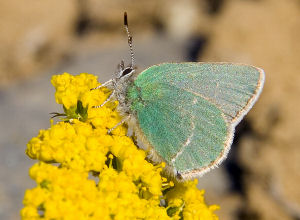Last week I went to a sort of panel or fair on pollinators of the Palouse. For those of you not in the area, the Palouse is a region in Idaho, Washington, and Oregon that is geographically unique and used to be mostly prairie. It's now primarily wheat and lentil fields, and of course towns, strip malls, and housing developments. This event was about how to make your yard into habitat for local pollinators by using native plants in your garden. Because 99% of the Palouse Prairie has been developed in the last 150 years, pollinators have trouble traveling between the scattered bits of habitat. By making our yards more hospitable, we create corridors and islands for the pollinators.Using indigenous plants not only attracts bees, butterflies, and birds, the garden will also be low maintenance and require much less water. Plus, bees and butterflies like the same things in gardens that we do: diverse colorful flowers all summer.
I'm only living in Idaho for another year, so I don't really have time to grow indigenous plants (the native plants aren't instantly gratifying the way many annuals are, and the next tenants might tear out whatever I've planted thinking they're weeds), but I think some of the information is useful and interesting no matter where you're gardening, and maybe my readers in this area will be inspired to incorporate some of these native plants into their yards.
Local pollinators, creatures that transfer pollen from plant to plant to fertilize them, include bees, butterflies, beetles, birds, and small mammals. Even ladybugs are pollinators. 10 species of bumble bees have been spotted in what's left of the Palouse Prairie, and 15 species have been spotted in our area. There are more than just the fuzzy yellow and black bees we're familiar with: this green metallic bee is part of the Halictidae family, just one example of many species of bees in our area.
When it comes to choosing flowers for your garden, choose multiple colors and shapes. Some species of pollinators like red flowers, some like blue. Some pollinators have long proboscae to reach into deep flowers, some have short proboscae and need a differently shaped flower. I've also heard that a pollinator-friendly garden has at least 9 species of plants: 3 to bloom early in the growing season, 3 to bloom in the middle, and 3 to bloom toward the end of the growing season. By choosing plants that grow in succession you guarantee there is always nectar available.
When creating butterfly habitit, it is important to provide not just plants with nectar, but also host plants. Butterflies lay their eggs on specific host plants, and the larvae will eat that plant after they hatch. Without the host plant, butterflies can't survive. So choose a few plants knowing they'll be sacrificed to the butterflies.
Each species of butterfly likes a different species of host plant. Some like birch trees, some serviceberry, some fennel. This Melissa Blue butterfly, one of our local pollinators, likes lupine as a host plant. That's good for you, because lupine is a lovely flower to have in your yard.
Another local, Sheridan's Green Hairstreak, lays it's eggs on wild buckwheat.
Milbert's Tortoiseshell lays its eggs on stinging nettle. That might not sound immediately appealing in your yard, but nettle leaves are rich in calcium, iron, vitamins A and C, and many other nutrients. I use to saute them and eat them like spinach.
That's enough for today. I'll talk more about native plant species next week.




No comments:
Post a Comment